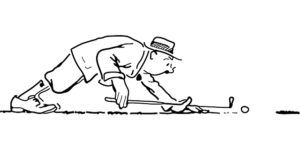Can One Live to 80 Without Any Ailments? It’ll Take More Than Luck and Genetics.

Turning 80 is apparently a pretty big deal. I just did it and found that it drew a lot more attention than when I turned 70 – or any other age I recall.
Except, perhaps, 21. For stupid adolescent reasons, I don’t remember much about that one. I was somewhere in Cheyenne, Wyoming with a group of fellow reprobates as I recall. Beyond that – well, that’s enough detail.
Turning 80 drew all the expected unhumorous funny cards, and the usual ageist remarks all delivered with a mix of love and pity.
I was told that finding a funny card – or any card, for that matter – for an 80-year-old is a lot tougher than finding one for 60- and 70-year olds. Makes sense since, the average amongst we U.S. males are unavailable to be recipients, having moved on at around 76.
How are you ailment free, they ask?
I can claim, unabashedly, that I’m fortunate to not look my age. I say unabashedly because it’s not an accident and it ain’t genetics. I work at it and have been for 40+ years.
Some are inclined to ask how I can get this far without major ailments.
If they only knew.
Behind what they see is an above average collections of maladies.
I tell folks that they’ll not likely get this far without a few. It’s really more of being able to live with them. Resilience is one of the characteristics found in those who live longer lives.
I’ve been trying to increase my resilience as the years have moved on.
Some “ailments” I’ve had for years. Both knees ache from 20 years of pickup basketball and two “clean up” surgeries; I just had an arthritic thumb joint removed that has hindered my love of golf and playing guitar for the last couple of years; at age 73, a CT scan revealed I have significant artery calcification which translates to cardiovascular disease; I have an under-active thyroid that I’ve medicated for 30+ years that makes weight control difficult and causes fatigue; I have atrial flutter (which is a first-cousin to atrial fib) for which I take a blood thinner. And my feet hurt about 24 1/2 hours a day.
Having said all that, I stay firm in my conviction that I can live well beyond the average lifespan for men, which has been steadily declining over the last several years in America. I don’t have symptoms of anything that would say that an early check out is imminent.
I admit to a modicum of fear of COVID and I’m remaining reasonably vigilant to avoid infection.
Here’s the point.
So much of how long we live and how we live long is between the temples. Few of us will avoid ailments because chances are, if we are an American, our lifestyle preceding our later years was – shall I say – less than stellar. We most likely ate badly because we were beholden, out of naivete, to the deplorable Standard American Diet (SAD).
And, most of us exercised far too little.
It’s really pretty simple. As a culture, we don’t really know jack about how our bodies and minds work and how to treat them optimally. And then we whine when we hit 60+ and some of our parts are acting like they are ready to be sent back to the universe.

I love the golf analogy. Nearly all of us have played a pretty crappy “front nine” with our lifestyles of comfort, convenience, and conformity and find ourselves either remorsing through a dismal back-nine or trying to make up for or reverse it on those final nine holes.
I’m the poster child for that. I smoked until age 37 and ate badly through my first 60 years. Although I have been a gym rat and avid exerciser for over 40 years, the CT scan at age 73 revealed the truth of how those first five decades+ had slowly, insidiously taken their toll.
So, resilience is part of the backbone of my existence as I march on this “pollyannish mission” to 100+. I work out aggressively – both aerobic and weight lifting – six days a week. It’s painful at every session, but I’ve learned to tolerate the pain in favor of the results. I’ve also moved my diet to a better balance of WFPB (whole-food-plant-based) and healthy fats and away from the Standard American Diet (SAD) C-R-A-P (calorie-rich-and-processed) diet that we Americans are captive to.
I choose to do the things that I know will maximize my chance of hitting my goal while having no illusions that I could be out of here by the end of the day. I’ve learned that all I have is today and have, with difficulty, learned the value of avoiding time travel into the future or the past.
It’s really all about ATTITUDE and RESILIENCE as we age. Do some research on the lives of centenarians, and you will find that nearly all of them have two consistent characteristics:
- They have endured and survived numerous health and mental challenges in their lifetimes.
- They have kept a sense of purpose and meaning in their lives, with the majority of them avoiding leisure-based retirement and staying engaged in some form of work.
If 80 is your goal (I suggest raising the bar – the human body can last to 112 years, 164 days), be prepared for ailments but adopt a “second half” lifestyle that will help you keep those to a minimum and give you more physical and mental strength to live with them.
How are you dealing with your “ailments?” Or maybe you don’t have any! We’d love to hear what works for you. Leave us a comment below or email us at gary@makeagingwork.com.





Gary, I think this is one of your best and most inspiring posts. Indeed, we always tend to look at the ‘lucky’ septua-/octogenarians and attribute it to good luck and genes, forgetting that they probably also carry their crosses (usually without complaining) and have had their fair share of health issues. AND that they work hard on their health to stack the odds in their favour. And, like you point out, you will live with some of the consequences of your life up to now, but it’s never to late to start living healthily (eating & exercising & keeping a sense of purpose) and the second-best time to start is NOW (the best being when you were young :).
at 74 i concur. we need to rethink “old”, females even more than us males. i was a life insurance actuary. 110 is possible for men…at today’s medical technology. good news is my wife is slightly younger, females will likely get a bonus 3-4 years to take care of us males. connie added 2 puppies to our life a few years ago. greatest insurance program ever. she might see 2 generations of them. play with puppies. kiss your partner. do a little yoga.
I grew up with a family history of diabetes ans appendix problems., both of which hit in my early teens.after treatments and operations, I had a fairly active live in school sports, wilderness roaming, and a 37 Mile return trip on bicycle to visit my girl friend which included up over a small mountain on the trip out.. School was a 5 mile bus trip in the morning, and a run home in the afternoon. this led to a great track history in Provincial competitions. Joining the Reserve Army Militia continued with miles of route marches, and more wilderness life that led to wilderness survival coaching and orienteering programs, both taking and teaching. all through life. At 82, I can still keep up to most friends of a near age, though slowing down somewhat.
Gary, I really liked this blog post. So honest about aches and pains, and being resilient and having a positive, purposeful attitude. Just got back from my hiking trip to Glacier NP and had a lot of pain in my IT band, but no hip pain, which I have been working on with PT. Asked today to shift the focus to strengthening the muscles around the IT band. I want to keep hiking/walking well into my 80’s or 90’s.
I am going to share this with my Hey, Boomer – What’s Next group if that is ok with you.